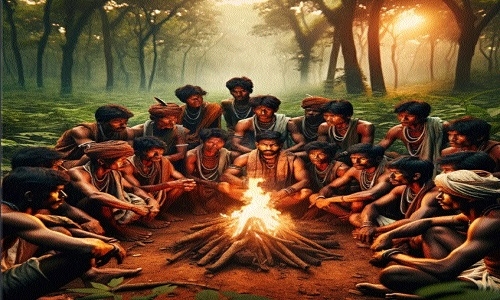Rediscovering Bastar’s forgotten tribal heroes
| Date :08-Jan-2024 |

By Dr Abhinav Mishra
In the shadowed forests of Bastar, during the oppressive British rule in India, a tale of unsung valour unfolds. The tribal people of this region, renowned for their desire for autonomy, were mercilessly subjugated under several draconian laws imposed by the British. They were trapped, desperate to break free from the colonial stranglehold, leading to Bhumkal revolt. While history remembers tribal heroes like Gunda Dhur and Gend Singh, it has largely forgotten others like Duma Mudiya and Malaul Mudiya, whose stories of bravery and sacrifice have been confined to the anecdotes of Abhujhmar in Bastar. At that time, the Bastar region was under the dual rule of the British and the Marathas, with their administrative centre in Nagpur (Maharashtra). The British, in their pursuit to control Jagdalpur, would traverse through Ravghat in Abhujhmar, looting tribal properties and their livestock and forcing them into laborious tasks like carrying palanquins. Duma Mudiya, an unsung martyr from the Abhujhmar region, was a symbol of resistance and respect.
His name, ‘Mudiya’, means ‘sir’ in the Gondi dialect, reflecting his revered status among the Halba and Muriya tribes of Dugal and Kolor forests of Narayanpur. Shiv Kumar Pandey, a distinguished expert in Bastar’s tribal history and culture, provided a harrowing account of these unsung heroes of Bastar and their brave stand against the British. He remarked, “Duma Mudiya was a brave soul who lived a life of celibacy and isolation, defending his land as if he was an incarnation of the local deity, Rav Baba. The Abhujmariyas believed that Rav Baba, also known as Raja Rav, was omnipresent at Ravghat, safeguarding not just the people but all flora and fauna. This spiritual belief fuelled their resistance and provided a sense of protection and resilience against the invaders”. Shiv Kumar further explained that Duma Mudiya led a small but fierce team of tribal soldiers, defending northern Narayanpur against all adversaries. His relentless defence and repeated victories against the British, who were determined to kill him, were attributed to his ardent devotion to Goddess Maavli. Legends say she was his constant protector, except for one fatal moment during his bath at River Talacher, which led to his brutal assassination.
Displaying extreme brutality, the enemy soldiers, after beheading Duma Mudiya committed further atrocities on his body. They drove a stick of Tendu wood deep into his head and impaled his torso with a bamboo stick, a grim testament to the cruelty he faced even in death. This savage act marked a tragic end to a hero who fought valiantly for his people and land. In parallel, the narrative of Malaul Mudiya unfolds during the Bhumkal revolt in 1910, where he stood against the British in Abhujhmar. Regarding another unsung hero of Abhujhmar, Shiv Kumar recounted, “Known for his adeptness in Tantric knowledge, Malaul created a mystical circle of protection, within which British bullets lost their lethality, while his arrows, bound with tantric energy, never missed their mark. However, in a desperate and cunning move, the British poured petrol into the river, setting it aflame. The sight of burning water scattered Malaul’s warriors, leaving him alone to fight.
Eventually, as his arrows dwindled and he was forced to step out of his circle, his powers faded, leading to his tragic capture. Bound to a Sal tree, he met a cruel end, filled with bullets and pierced with bamboo”. Both Duma and Malaul’s sacrifices are barely a whisper in our history books. Yet, in Abhujhmar, their legacy is profound and poignant. The tribals of Narayanpur have erected a ‘mrityu stambh’ (Pillar of Death) for Duma Mudiya, a solemn reminder of his bravery and the brutality he faced. Meanwhile, the tree to which Malaul Mudiya was tied, riddled with bullet marks, stood as a silent witness to his valour until it was cut down for a route to Orchha.
